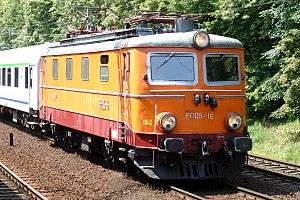PKP class EP05
The EP05 is a Polish modification of Czech electric locomotive EU05 used by Polish railway operator (PKP).
| PKP class EP05 | |||||||||||||||||||||||||||||
|---|---|---|---|---|---|---|---|---|---|---|---|---|---|---|---|---|---|---|---|---|---|---|---|---|---|---|---|---|---|
 EP05-16 at Warszawa Ochota station, 2007. | |||||||||||||||||||||||||||||
| |||||||||||||||||||||||||||||
| |||||||||||||||||||||||||||||
| |||||||||||||||||||||||||||||
| |||||||||||||||||||||||||||||
History
The locomotive was produced in the years 1957–1960 in three types: 20E1, the prototype, 30E1 and 30E2. In need of modern electric locomotives for passenger trains, and unable to get timely delivery of EU06 locomotives from England, Poland bought 30 locomotives from its southern neighbours.
In 1969, PKP started testing several changes to enable EU05 locomotives to achieve speeds up to 160 km/h (99 mph). First trials were made with the EU05-29 locomotive, and soon it became clear that it was possible to safely achieve speeds up to 170 km/h (106 mph) after changing the transmission rate. The decision was made to rebuild all locomotives of EU05 class during first servicing. As a result, by 1977 almost all locomotives had been rebuilt to EP05 class, except for locomotives 09, 12 and 19, which had been scrapped earlier. To distinguish the new series from its predecessor, the color scheme was changed from two-tone green to orange. All modifications were conducted in Zakłady Naprawcze Taboru Kolejowego in Gdańsk.
In the beginning of the 1980s, EP05 was being prepared for pulling express trains. Most of the engines had had multiple steering and pneumatic devices installed, which allowed them to pull trains with two connected locomotives and operate automatic fixtures. First express train, Górnik (En.: miner) led by EP05 locomotive run in 1984 on Centralna Magistrala Kolejowa, achieving a top speed of 138.2 km/h (86 mph). In the second half of the 1980s the top speed on Centralna Magistrala Kolejowa rose to 160 km/h (99 mph) and as a result EP05 could run at top speed. Some of those engines later had their clutch changed from Secheron to Skoda.
Present day
Following the introduction of EP09 locomotives, EP05 started to be withdrawn from service, but due to several break downs of EP09 it was postponed. Today only one unit (EP05-23) of this locomotive still run under PKP Cargo, pulling InterCity trains. There is also one unit of EU05 left in service, which is in fact EP05-22 engine repainted in 2003. It serves as an exhibit in Kraków. As of 2018, it has been restored and re-entered regular service, at speeds of 160 km/h. EP05-23 Re-entered regular Service As an Active Exhibit In 2017. Repainted Back To The Orange Livery in the same year, EP05-23 unit is owned by PKP Intercity
Technical data
EP05 series locomotive is a passenger electric locomotive able to pull passenger trains. It has steering cabins on either end of the box. On a straight, horizontal track it could pull 600 t. passenger trains with a top speed of 160 km/h.
Nicknames
- Piątka (eng. The Five) - from locos number
- Czesio (eng. The Czech) - from name of country where was produced (Czech Republic)
References
- "History of EU05 and EP05 series". Retrieved June 7, 2007.
- "Technical data of EP05, EP08 and EP09 locomotives". Archived from the original on June 7, 2007. Retrieved June 7, 2007.